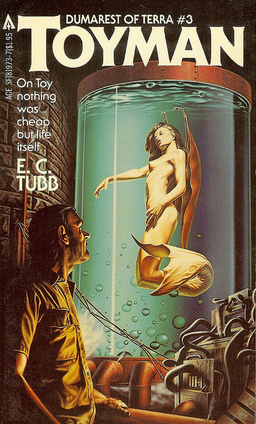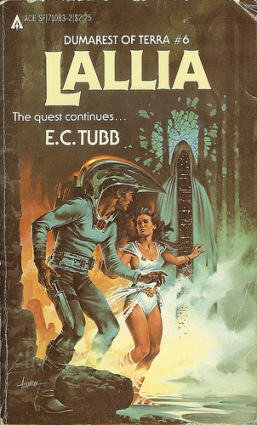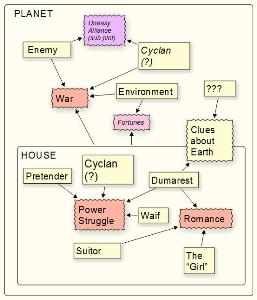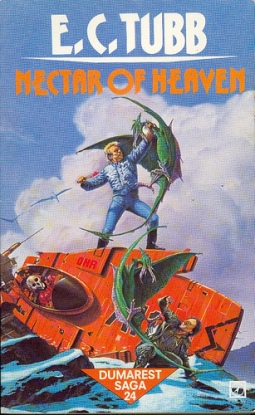Series Architecture: The Same But Different in EC Tubb’s Dumarest

EC Tubb’s Dumarest serial is oddly compelling… so oddly compelling that, if you like the first book, you end up slowly chugging through the series.
For those who’ve just tuned in, this is an incredibly long mid-20th century low Space Opera serial that influenced the roleplaying game Traveller. Note, series not serial: though there is forward momentum, each book is standalone — it’s more Deep Space Nine than Babylon 5. Also note the low. This isn’t exactly Conan in Space, but the Cimmerian would not be out of place.
So, Dumarest wanders a Grapes of Wrath galaxy — think how we met Rey in The Force Awakens — in search of Earth while pursued by the fanatical Cyclan, cyborg monks with no emotions other than the hunger for power and pride in their intellect.
It’s very much The Fugitive does Space Western. There are exceptions, and Tubb often kicks off with a short story before settling down the real meat. However, in almost every episode, Dumarest is the archetypal Drifter who becomes involved in gothic goings on in one of the local great houses, usually because that house faces some external threat.
(The houses are usually Gormenghast-style piles crammed with extended family and fuelled by dwindling fortunes. However, from time to time he swaps in military unit, spaceship, expedition, clan or band, with similar effect.)
This happens so consistently, that the books should be too formulaic to keep coming back to.
But we do. Each novel is the same but different.
How did — does — he do it?

First, Tubb is incredibly economic with the… backbone of the story. Just three elements — FATE RPG would call them “Aspects” — generate most of the underlying conflict.
(1) Dumarest is a veteran traveler on a quest staying just ahead of his enemies. He is lonely, but cannot stay. His skills tempt him to help the unfortunate, but does not want to get involved. Though he does not want to get involved, his search for clues pointing to Earth forces him to stay long enough that he does get involved.
These internal conflicts echo his impact on the people around him. He’s attractive to women (because rugged bad boy) but they know they can’t keep him and their family disapprove. He’s a potential ally in local conflicts (because skillset), but — since he has no local network — politically and socially weak when he takes sides.
(2) The great houses are old. This makes them proud but decaying, durable but unadaptable, in need of new blood/ideas but too conservative to accept them, and loyal but untrusting.
(3) The Galaxy is so soul-suckingly big that you can lose a planet in it! So it offers novelty but rootlessness, diversity but isolation, and hope but peril.
(The other elements and players contain similar contradictions. The Cyclan, for example, are all about intellect, which makes them smart but foolishly arrogant.)
There you have it: Dumarest is a questing traveller. The great houses are old. The Galaxy is big.
From a reader point-of-view, these are a starkly powerful trio of archetypes. They’re probably why we want to buy the next book(s). Together they generate enough complexity to make the story vivid and intriguing while still easy-to-follow, which probably explains why we find them so entertaining. And, archetype and complexity themselves combine to make the stories feel strangely satisfying… a bit more significant than just a throwaway read.
From the writer point-of-view, this is a great way to make the material manageable. In a Science Fiction universe where potentially anything can happen, it’s good to have a simple backbone to cling onto.
Tubb is similarly economical when he builds his scenarios. Here’s my diagram of a typical Dumarest episode (right).

Tubb generally has just two nested arenas in which the three main conflicts play out:
First, the Planet, where there’s a… (1) WAR. Enemy versus Great House, including Dumarest. The Environment is also a player, though one to be exploited by both sides. (There’s also usually a subplot to do with the fortunes of the house versus the environment.)
On the planet, there’s the Great House (or spaceship or military unit or whatever) where there’s: a (2) POWER STRUGGLE between a Waif, on whose side Dumarest intervenes, versus a Pretender (e.g. an evil uncle); and a (3) ROMANCE that’s really a three-sided conflict between the “Girl” (mid 20th century terminology, sorry), Dumarest (can she win his love and make him stay?), and her Suitor (usually a more suitable young man).
These three conflicts — War, Power Struggle and Romance — are themselves archetypal and give the reader something to hang onto as the story twists and turns.
Because they co-exist and interact, these three conflicts also generate enough story possibilities to provide variation between books: the suitor may be tempted to side with the rival, or prove himself in the war… The Pretender may threaten the Girl, or change sides in the War… players may be close friends or relatives with each other so that the Suitor is the ally of the Waif.. and so on.
Tubb often merges the players in interesting ways. Most obviously, the Waif is the Girl and the Suitor is the Pretender. But what if the Waif is the Suitor? Or the Girl is the Pretender? Or if somebody is being duplicitous?

Tubb also varies his arenas. Sometimes the planet doesn’t really figure and everything happens within the house (or city, clan or ship), or the house and the planet are the same.
Finally, Tubb has two conflicts that Dumarest trails around between books. They not only connect each episode, they’re also what get him involved and what keep him moving on, and in doing so add complexity and time constraint to each story:
Dumarest versus whatever stops him finding Earth. It’s one of those Who’s-Afraid-of Virginia-Wolf-Unhealthy-20th-Century-Style obsessions. It’s integral to his character, affects his involvement in the three main conflicts, but also creates more standalone conflicts as he battles against whatever or whoever stands in his way.
Dumarest versus the Cyclan. The Cyclan want to wrest certain knowledge from his brain then eliminate him. Whether they are already involved in the situation, or whether they insert themselves specifically for the task, they usually spend some of each book going after Dumarest through either the Power Struggle or the War.
* * *
And that’s it.
Three aspects, two arenas, three main conflicts yields thirty-three Dumarest novels.
Is this the best way to approach writing a series? Unlike Star Trek, it means inventing a new ensemble cast for each episode. However, because it’s new each time, your ensemble need never run out of plot, and you need never get tied up with tracking continuity.
I don’t know about you, but I’m tempted to give something like this a go.
M Harold Page is the Scottish author of The Wreck of the Marissa (Book 1 of the Eternal Dome of the Unknowable Series), an old-school space adventure yarn about a retired mercenary turned archaeologist. He’s on a quest to find the mythical Dome but keeps getting involved in “local difficulties”. You can get it on Kindle here.
You nailed it, Mr. P. I liked the first one, and have indeed been “slowly chugging through the series” at the rate of one a summer since then. I suppose at some point I’ll have to pick that pace up a bit if I ever want to finish the series.
Dumarest himself is a very satisfying character – highly competent but not a superman, taciturn but not an emotional robot, with a master-motive that’s thoroughly believable and that only grows stronger with frustration.
One more thing – Tubb was a first-rate action writer. I always look forward to the combats that Dumarest gets involved in; those sequences are invariably top-notch.
Does anybody remember the original Early Seventies covers? For some reason the artist decided Earl looked like a porn star circa the same era (ie, long hair and moustache).
I only discovered a few years back that Tubb wrote westerns prior to switching over to SF. Certainly the Dumarest series has a lot of Western tropes (although Earl’s specialty was a knife rather than six-shooter). The plots were fairly formulaic, but Tubb usually introduced something sufficiently new into the mix with each book to justify it, and there were a couple of variations on a familiar theme – like when a sentient planet falls in love with Earl in ‘Mayenne’ or when it’s a young man who is infatuated with Earl rather than a woman.
http://d2arxad8u2l0g7.cloudfront.net/books/1440110918l/3422555.jpg
Aonghus Fallon: MY EYES MY EYES
> there were a couple of variations on a familiar theme – like when a sentient planet falls in love with Earl in ‘Mayenne’ or when it’s a young man who is infatuated with Earl rather than a woman.
Exactly!
Planet merges with Girl.
Girl merges with Waif and is a boy.
One set of archetypes, a zillion possibilities.
Classy, huh? The later covers are a big improvement. How could they not be? Although I’m not sure any of them close to my mental picture of what Dumarest actually looked like.
It’s my understanding that Tubb didn’t originally intend for the series to go on for nearly as long as it did – Donald Wollheim encouraged him to keep spinning it out, because sales were good. Then sales declined and DAW dropped the series, leaving Tubb stranded ten million light-years from home, as it were.
This article reminds me of a similar work at Internet Review of Science Fiction from back in ’05– http://www.irosf.com/q/zine/article/10119
Of course, I have the same question then that I have now: does anybody actually PLAY Traveller? I’ve met people who collect it, are devoted to it, but not who actually play it.
@Adrian Simmons – Thanks for the link! Looks like an interesting read.
I think the problems with traveller are twofold:
1. It’s set in a middle aged story world with “real” structures such as companies and government agencies that are beyond the grasp of most 12-year-olds obsessive enough to learn and handle the rules.
2. It has this “show your workings” vibe, which militates against replicating the pulp/ noir SF stories that inspires it.
Personally, I like FATE Diaspora, which is what I GM: https://www.blackgate.com/2014/04/24/roleplaying-game-review-fate-and-fate-diaspora/
Good article and analysis.
I read all the Dumarest novels (except the last one that was for a while only available in French I think) a couple of decades ago. And while I didn’t do the detail analysis you did, I certainly noticed the formula, and the repeated tropes like the knife fights in arenas, and the nearly but not quite identical paragraph in every novel about the local Cyclan merging with the group mind (and the Homuchin elements or whatever … I forget the details). (And planet after planet with a name that’s a pun on Earth or Terra.)
Yes, it’s formulaic stuff, and pretty routine, and only competently written, but it’s still fun, and like you say, oddly compelling.
I think TOYMAN was the first I read — the original edition, half of an Ace Double, in my case bought at a used bookstore as literally just half — the other half torn off.
That is a nicely varied formula. I can see how, in the hands of a kickass writer, it would be nigh irresistible.
Have to resist nonetheless.
Thirty-three novels, leading to no conclusion? That’s an undertaking I might have signed on for as a younger reader when I felt like I had forever to linger in all the books I could ever want to read. But at my reading speed, my enormously long TBR list may outlive me.
I knew people in college who played Traveller. My old gaming gaggle tried it for a three-episode campaign, and it didn’t do much for us, but that was so long ago I don’t remember why not. We were more into Call of Cthulhu, Shadowrun, and an unholy homebrew of a system that never met a fiddly detail it didn’t like.
@Sarah
As I understand it, book 33 DOES bring the series to a conclusion, but I have not wanted to spoiler myself to find out what: http://jeffbuser.com/Dumarest/bibliography.html
The books are short, 130 to 180 pages typically, so the equivalent of 3 Peter F Hamilton or George R R Martin volumes.
Tubb (and readers) manage to “have it both ways”: the series does and does not have a conclusion. In the last Dumarest novel, Temple of Truth, Dumarest has found the coordinates of Terra and has sufficient funds to, in theory, to get there, so he “wins.” On the other hand, the Cyclan is still after him, and as it seems to be strongly hinted in the first novel or two of the series, the Cyclan is headquartered on Terra, so Dumarest is still facing a great challenge. (And it is somewhat puzzling to me that the first books seem to give away the location of the Cyclan, and then the whole subject is dropped — the highly suspicious and intelligent Dumarest never even speculates about the location of Cyclan headquarters in the later books, which is something which one would think would concern him . . . )
The final, previously unpublished, volume in which he actually reaches Terra is now on amazon!
I have been rediscovering boxes of books in my basement. I just found a stack of 23 paperbacks (some of the oldest being Ace Doubles) with all of the Dumarest novels through the last DAW edition, most of which I bought as they were published.
“Earth? Who would name a planet Earth? Might as well name it Soil, or Dirt.” But Earl Dumarest is certain of the name of his homeworld. Yes, after the first four or five, they become episodic in the old-fashioned TV sense: standalone story, with continuing threads of the ongoing quest to find his way home, the constant pursuit for the secrets he carries, and the new adventures in each port of call. One could draw parallels to Westerns where “our hero” passes through one little town after another, and always – regretfully, almost against his will – finds himself drawn into some local conflict and some local romance. One could also compare to James Bond, except that Bond falls short.
There are paragraphs one starts to recognize as they repeat: the description of the Cyclan, the credo of the Universal Brotherhood, the description of traveling “low” riding “doped, frozen and ninety percent dead”. But then, an episodic series needs to orient new readers, so it’s forgivable.
People complain about Star Trek TOS or the original Battlestar Galactica being “formulaic” in comparison to modern shows. Well, sure, they were in keeping with the previous style, and they set a tone for the future. Same here.
M Harold Page here
I think, TV-wise, Dumarest is The Fugitive but in Space. At various times it does arc, and generally makes sense when read in the right order.
It’s worth also noting that the previously unpublished finale is now on Amazon.
The last book is ‘the return’ then? I have read that it was 32 in the series but someone mentions that there are 33. Am I missing one? I just ran across a signed special first edition of the return (74 of 100). Paper dust jacket and signed by tub, Turner and harbottle on a red insert page. Does anyone know whether this is collectible and has any value? I always expected that the cyclan would have their base on Earth, and suspected the dumarest would have some sort of tie in with them as a child on the planet. And some sort of final showdown with the cyclan when he landed on Earth.